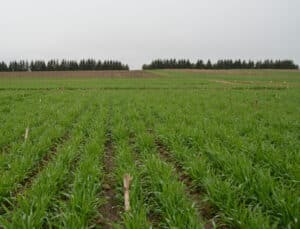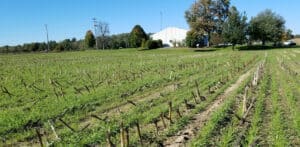Nathan Johanning – University of Illinois Extension
May 2021
Midwest Cover Crops Council (MCCC-125)
University of Guelph (SAG-FS-20-001)
This publication is intended to provide a starting point for farmers who are new to growing cover crops. With experience, farmers may fine-tune the use of cover crops for their systems.
The following recipe provides an introductory approach to integrating a cover crop after corn silage harvest and before planting soybean as the next crop.
Fall Work

Cover Crop Selector Tool —available from Midwest Cover Crops Council
Publication 811, Agronomy Guide for Field Crops (OMAFRA)
Publication 75A, Guide to Weed Control: Field Crops (OMAFRA)
Cover Crops (OMAFRA web publication)
Double Cropping Fall Rye for Extra Forage (OMAFRA web publication)
Get a Jump on Early Spring Forage (OMAFRA web publication)
Cameron Ogilvie, University of Guelph; Jake Munroe, OMAFRA; Mike Cowbrough, OMAFRA; Christine O’Reilly, OMAFRA; Laura Van Eerd, University of Guelph; Anne Verhallen, OMAFRA
Dale Cowan, AGRIS Co-operative Ltd.; David Hooker, University of Guelph; Peter Johnson, Real Agriculture; Darren Robinson, University of Guelph; Peter Sikkema, University of Guelph; and François Tardif, University of Guelph
August 2020
The U.S. Department of Agriculture (USDA) prohibits discrimination in all its programs and activities on the basis of race, color, national origin, age, disability, and where applicable, sex, marital status, familial status, parental status, religion, sexual orientation, genetic information, political beliefs, reprisal, or because all or a part of an individual’s income is derived from any public assistance program. (Not all prohibited bases apply to all programs.) Persons with disabilities who require alternative means for communication of program information (Braille, large print, audiotape, etc.) should contact USDA’s TARGET Center at (202) 720-2600 (voice and TDD). To file a complaint of discrimination write to USDA, Director, Office of Civil Rights, 1400 Independence Avenue, S.W., Washington, D.C. 20250-9410 or call (800) 795-3272 (voice) or (202) 720-6382 (TDD). USDA is an equal opportunity provider and employer. ©2020 by MCCC. All rights reserved.
Midwest Cover Crops Council (MCCC-123)
Michigan State University Extension (CC-06)
This publication is intended to provide a starting point for farmers who are new to growing cover crops. With experience, farmers may fine-tune the use of cover crops for their systems.
The following recipe provides an introductory approach to integrating a cover crop after corn silage harvest and planting corn for grain or silage as the next crop.

Cover Crop Selector Tool —available from Midwest Cover Crops Council
Recommended Hay and Pasture Forages for Michigan (Michigan State University Extension publication E-3309)
Weed Control Guide for Field Crops (Michigan State University Extension publication E-0434)
NRCS Cover Crop Termination Guidelines—available from the USDA–National Resources Conservation Service
Cover Crop Termination (Michigan State University Extension website)
Cover Crops, Manure, and Nitrogen Management (University of Wisconsin–Madison Extension publication A4178)
Dean Baas, Kimberly Cassida, Christina Curell, Sarah Fronczak, Paul Gross, Monica Jean, Phil Kaatz, and Elizabeth H. Schultheis, Michigan State University (Note: This publication was adapted with consent from MCCC under a joint project to produce customized introductory guidance about cover crops for all member states/provinces.)
Boyd Byelich, USDA–Natural Resources Conservation Service; Erin Hill, Michigan State University; Eileen J. Kladivko, Purdue University; Anna Morrow, Midwest Cover Crops Council; and Maninder Singh, Michigan State University
August 2020
The U.S. Department of Agriculture (USDA) prohibits discrimination in all its programs and activities on the basis of race, color, national origin, age, disability, and where applicable, sex, marital status, familial status, parental status, religion, sexual orientation, genetic information, political beliefs, reprisal, or because all or a part of an individual’s income is derived from any public assistance program. (Not all prohibited bases apply to all programs.) Persons with disabilities who require alternative means for communication of program information (Braille, large print, audiotape, etc.) should contact USDA’s TARGET Center at (202) 720-2600 (voice and TDD). To file a complaint of discrimination write to USDA, Director, Office of Civil Rights, 1400 Independence Avenue, S.W., Washington, D.C. 20250-9410 or call (800) 795-3272 (voice) or (202) 720-6382 (TDD). USDA is an equal opportunity provider and employer. ©2020 by MCCC. All rights reserved.
Midwest Cover Crops Council (MCCC-124)
Michigan State University Extension (CC-07)
This publication is intended to provide a starting point for farmers who are new to growing cover crops. With experience, farmers may fine-tune the use of cover crops for their systems.
The following recipe provides an introductory approach to integrating a cover crop into a corn silage–soybean rotation.

Cover Crop Selector Tool —available from Midwest Cover Crops Council
Recommended Hay and Pasture Forages for Michigan (Michigan State University Extension publication E-3309)
Weed Control Guide for Field Crops (Michigan State University Extension publication E-0434)
NRCS Cover Crop Termination Guidelines—available from the USDA–National Resources Conservation Service
Cover Crop Termination (Michigan State University Extension website)
Cover Crops, Manure, and Nitrogen Management (University of Wisconsin–Madison Extension publication A4178)
Dean Baas, Kimberly Cassida, Christina Curell, Sarah Fronczak, Paul Gross, Monica Jean, Phil Kaatz, and Elizabeth H. Schultheis, Michigan State University (Note: This publication was adapted with consent from MCCC under a joint project to produce customized introductory guidance about cover crops for all member states/provinces.)
Boyd Byelich, USDA–Natural Resources Conservation Service; Erin Hill, Michigan State University; Eileen J. Kladivko, Purdue University; Anna Morrow, Midwest Cover Crops Council; and Maninder Singh, Michigan State University
August 2020
The U.S. Department of Agriculture (USDA) prohibits discrimination in all its programs and activities on the basis of race, color, national origin, age, disability, and where applicable, sex, marital status, familial status, parental status, religion, sexual orientation, genetic information, political beliefs, reprisal, or because all or a part of an individual’s income is derived from any public assistance program. (Not all prohibited bases apply to all programs.) Persons with disabilities who require alternative means for communication of program information (Braille, large print, audiotape, etc.) should contact USDA’s TARGET Center at (202) 720-2600 (voice and TDD). To file a complaint of discrimination write to USDA, Director, Office of Civil Rights, 1400 Independence Avenue, S.W., Washington, D.C. 20250-9410 or call (800) 795-3272 (voice) or (202) 720-6382 (TDD). USDA is an equal opportunity provider and employer. ©2020 by MCCC. All rights reserved.
Kim Cassida and Phil Kaatz – Michigan State University Extension
November 2019
Recommended Hay and Pasture Forages For Michigan
Source link here.
Kim Cassida and Joe Paling – Michigan State University Extension
February 2020
2019 MSU Cover Crop Variety Test Report
Source link here.
University of Wisconsin, Nutrient and Pest Management Program
Cover Crop Termination Options
Source link here.